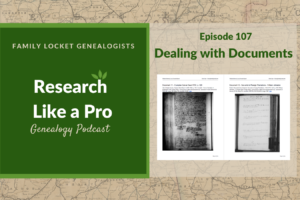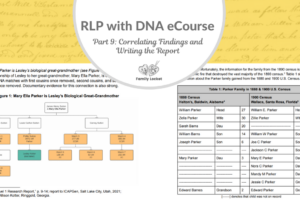
Writing a report is a crucial step in our research. As we write, we synthesize the many details we’ve explored and put them together in an organized fashion. This allows us to bring a research phase to a close and provides the next steps for a future research phase. The search for Cynthia’s father continues, but in this phase, I successfully eliminated some candidates and found new opportunities to research. I’ve included the report at the end of the post.
Previous posts in this series:
Revisiting the Father of Cynthia (Dillard) Royston: Part 1 Objective
Revisiting the Father of Cynthia (Dillard) Royston: Part 2 Timeline and Analysis
Revisiting the Father of Cynthia (Dillard) Royston: Part 3 Locality Research
Revisiting the Father of Cynthia (Dillard) Royston: Part 4 Research Planning
Revisiting the Father of Cynthia (Dillard) Royston: Part 5 Research Logging and Citations
The following was written with the assistance of AI based on the completed report.
Setting the Stage: Objective and Limitations
Every solid research report begins with clarity about what you’re trying to accomplish and what constraints you’re working within. For this project, I established a clear objective:
Discover a candidate for Cynthia (Dillard) Royston’s father residing in Cass County, Georgia, during the 1830s. Cynthia was born about 1815 in Georgia and died on 22 August 1882 in Collin County, Texas. Cynthia married Thomas B. Royston about 1833 or 1834, possibly in Cass County, Georgia.
The limitations section proved equally important. I documented that research took place between September and November 2025, was limited to online records and those accessible at the FamilySearch Library in Salt Lake City, and faced a significant challenge: the earliest deed books for Cass/Bartow County are missing, with deed records only beginning in 1837. This meant I couldn’t access land transactions during the crucial period when Cynthia’s father would have been acquiring property. I also noted that this research phase did not include DNA analysis, though previous phases had.
Being transparent about limitations helps readers understand the research’s boundaries and sets realistic expectations for the findings.
Building Context: The Background Information Section
The Background Information section is where I laid the foundation for understanding why this research mattered and what had already been accomplished. This section had several key subsections:
Project Overview
I opened by establishing who Cynthia (Dillard) Royston was: born approximately 1815 in Georgia, died August 2, 1882, in Collin County, Texas. Her maiden name of Dillard was known only from the death certificates of three of her fourteen children. The research objective was to identify her father, who would have been born before 1795, likely in Virginia, and residing in Georgia during the 1820s and 1830s.
Cynthia’s Life and Migration
Understanding Cynthia’s life helped establish geographic and temporal parameters. She had fourteen children with Thomas B. Royston, including three sons who died in the Civil War. Thomas settled in DeKalb County, Alabama, by January 1837, having moved from Georgia. Importantly, Thomas enslaved nine people in 1840, suggesting he may have originated from a family of similar economic standing—a detail that could inform the search for Cynthia’s father.
Previous Research Phases
This is where documenting previous work became crucial. I summarized three earlier research phases:
Phase 1 examined George W. Dillard as a potential father candidate. The 1820 and 1830 census records showed a female of Cynthia’s age in his household, and there was proximity of residences in Alabama. However, a family bible proved this hypothesis wrong—the Dillard female born in 1815 was Mariah L. Dillard, not Cynthia.
Phase 2 systematically eliminated thirteen Georgia Dillard candidates based on probate records, marriage records, wills, and census analysis. Each candidate was documented with specific reasons for elimination—for example, Arthur Dillard’s will named only two daughters (Nancy Harmon and Elizabeth Joslin), and Samson Dillard’s 1848 will named four daughters (Nancy Yeaman, Phoebe Durdin, Mary Davis, and Zilpha Yeoman).
Phase 3 introduced DNA analysis, which revealed a distinct cluster suggesting that Elijah Dillard (born about 1814-1816 in Georgia, died September 6, 1886, in Pike County, Alabama) could be Cynthia’s brother. Documentary research documented Elijah’s life in southeastern Alabama through land patents, marriage records, and census records.
By thoroughly documenting what had already been tried, I showed that this wasn’t the first attempt to solve the mystery—it was a carefully reasoned next step based on accumulated evidence.
The Heart of the Research: Cass County Investigation
This section contains the original research conducted for this research phase. I organized it into several strategic subsections:
Historical Context of Cass County
Understanding the historical context was essential. Cass County was formed on December 3, 1832, from Cherokee Nation lands following Georgia’s land lottery system. This timing aligned perfectly with Cynthia’s estimated marriage date to Thomas B. Royston. The settlement patterns following Cherokee removal provided crucial context for identifying which Dillard families migrated to this newly opened territory and when they arrived. Understanding that settlers primarily came from Georgia, Tennessee, and the Carolinas helped establish migration patterns.
The 1840 Census: Finding the Dillards
The 1840 census of Cass County revealed four Dillard households: Elizabeth, John Dillard, William Dillard, and Elijah Dillard. I analyzed each household’s composition to determine which individuals were old enough to be Cynthia’s parent. 1


I systematically researched each household seeking to identify these Dillards and see if Cynthia fit.
- Elizabeth Dillard was traced to Laurens County, South Carolina, with a distinct migration pattern and census district. Her appearance in Cass County, Georgia, after Cynthia had moved to Alabama with Thomas B. Royston eliminated her as a relative.
- John Dillard and his sons, William and Elijah, were tracked from North Carolina through Monroe County, Tennessee, before settling in Cass County. Deed records naming John Dillard’s heirs revealed that Cynthia was not among them, ruling out this family line.
- The Elijah Dillard in Cass County in 1840 was confirmed to be John Dillard’s son from North Carolina, not the Elijah Dillard (born circa 1814-1816) identified through DNA analysis as Cynthia’s probable brother.
The Cherokee Land Lottery of 1832
The 1832 Cherokee Land Lottery distributed standard 160-acre land lots to white male Georgia residents. I identified all Dillard fortunate drawers from the lottery and noted their counties of origin and where their land lots were located.
While no Dillards drew lots specifically in Cass County through the land lottery, several drew lots in neighboring counties, including William Dillard in Cherokee County.
The Georgia Gold Lottery of 1832
The Gold Lottery proved to be the breakthrough. Conducted separately from but concurrent with the Cherokee Land Lottery, it distributed 40-acre parcels in gold-bearing areas. The discovery of gold in Cherokee territory in the late 1820s had attracted prospectors and increased pressure for Cherokee removal.
For the report, I included a map of the 1832 Land and Gold lotteries and the sections, highlighting Cass County and Walker County (not accurately depicted in the map).2

I identified three Dillard men who drew gold lottery lots specifically in Cass County:
- James Dillard of Pulaski County (Lot 1119/3, Section 3)
- Joseph B. Dillard of Oglethorpe County (Lot 969/2, Section 3)
- Roliver (possibly Toliver) Dillard of Burke County (Lot 893/3, Section 3)
These three fortunate drawers represent the highest-priority candidates for future research. Their presence in Cass County through land ownership during the early 1830s placed them in the correct geographic location and time period for Cynthia’s marriage to Thomas B. Royston.
Creating a Prioritized Research List
I organized all the Dillard lottery winners into a prioritized list based on the county where their land lots were located. Cass County Dillards received top priority, followed by those in neighboring counties (Cherokee, Cobb, Forsythe, Lumpkin, Murray/Gilmer, Paulding, Union, and Walker counties).
Now I have a clear roadmap for future research efforts.

Portion of the table showing a prioritized list of Dillard individuals to research
Drawing Conclusions
The Conclusion section addressed what was accomplished and what wasn’t. I acknowledged that the central research question—”Who is Cynthia Dillard’s father?”—remained unresolved. However, the research made significant progress:
- Four Dillard individuals in Cass County in 1840 were identified and systematically researched.
- All were definitively eliminated as relatives of Cynthia.
- Three new high-priority candidates were identified through the gold lottery research.
I noted that documentary research on these three specific gold lottery winners had not yet been conducted, complicated by the loss of early Cass County deed books. This gap in the record would challenge efforts to trace these men through traditional documentary sources.
The DNA hypothesis linking Elijah Dillard to Cynthia remains a promising lead. The combination of documentary evidence (Cass County as the likely marriage location) and DNA evidence suggested that Cynthia’s father may have had ties to both Cass County, Georgia, and southeastern Alabama, where Elijah Dillard later lived.
Future Research Directions
The Suggestions for Future Research section provides a roadmap for the future. The identification of James Dillard, Joseph B. Dillard, and Roliver (Toliver) Dillard as Cass County gold lottery winners offered specific, named candidates for targeted research—a promising path forward for identifying Cynthia’s parents. I also noted additional DNA work to be done, including finding a Y-DNA tester from descendants of Elijah Dillard.
Tips for Writing a Research Report
Several key principles guided the writing of this research report:
1. Document Everything: Every claim was supported by properly formatted source citations. When sources were accessed online, I included access dates. When I used AI tools (Claude) to summarize historical context, I cited that as well.
2. Show Your Work: By detailing the research in previous phases, I demonstrated that this wasn’t random searching but a systematic, reasoned approach building on prior work.
3. Be Honest About Limitations: Acknowledging missing deed books and the constraints of online research builds credibility and helps future researchers understand the boundaries of the work.
4. Think Geographically and Historically: Understanding the formation of Cass County, the Cherokee removal, and the lottery systems provided essential context that led to identifying new candidates.
5. Create Clear Next Steps: The prioritized list of lottery winners gave future researchers specific names and locations to investigate rather than vague directions.
6. Use Visual Aids: Maps showing land lot locations and census district boundaries helped readers visualize the geographic relationships that were central to the research.
7. Combine Multiple Evidence Types: The most powerful analysis came from combining documentary evidence (land lotteries, census records, deed records) with DNA analysis results from earlier phases.
Final Thoughts
This research session didn’t solve the mystery of Cynthia Dillard’s father, but it provides three specific candidates for the next phase! Sometimes that’s all we can ask of a complex research scenario.
If you’d like to read the entire report, I’ve uploaded it here: Cynthia Dillard Father Candidate Phase 4 Oct 2025

Best of luck in all your genealogical endeavors!
Sources
- 1840 U.S. census, Cass County, Georgia, District 951, p. 115 (penned), line 20, Elizabeth Dillard; imaged, “1840 United States Federal Census,” Ancestry (https://www.ancestry.com/search/collections/8057/ : accessed 31 August 2025). Also, 1840 U.S. census, Cass County, Georgia, District 973, p. 78 (penned), line 4, John Dillard, line 5 William Dillard, line 16, Elijah Dillard; imaged, “1840 United States Federal Census” Ancestry (https://www.ancestry.com/search/collections/8057/ : accessed 31 August 2025).
- James F. Smith, The Cherokee Land Lottery of Georgia: Containing a Numerical List of the Names of the Fortunate Drawers in Said Lottery; with an Engraved Map of Each District (Greenville, South Carolina: Southern Historical Press, 1991, c1968).














Leave a Reply
Thanks for the note!